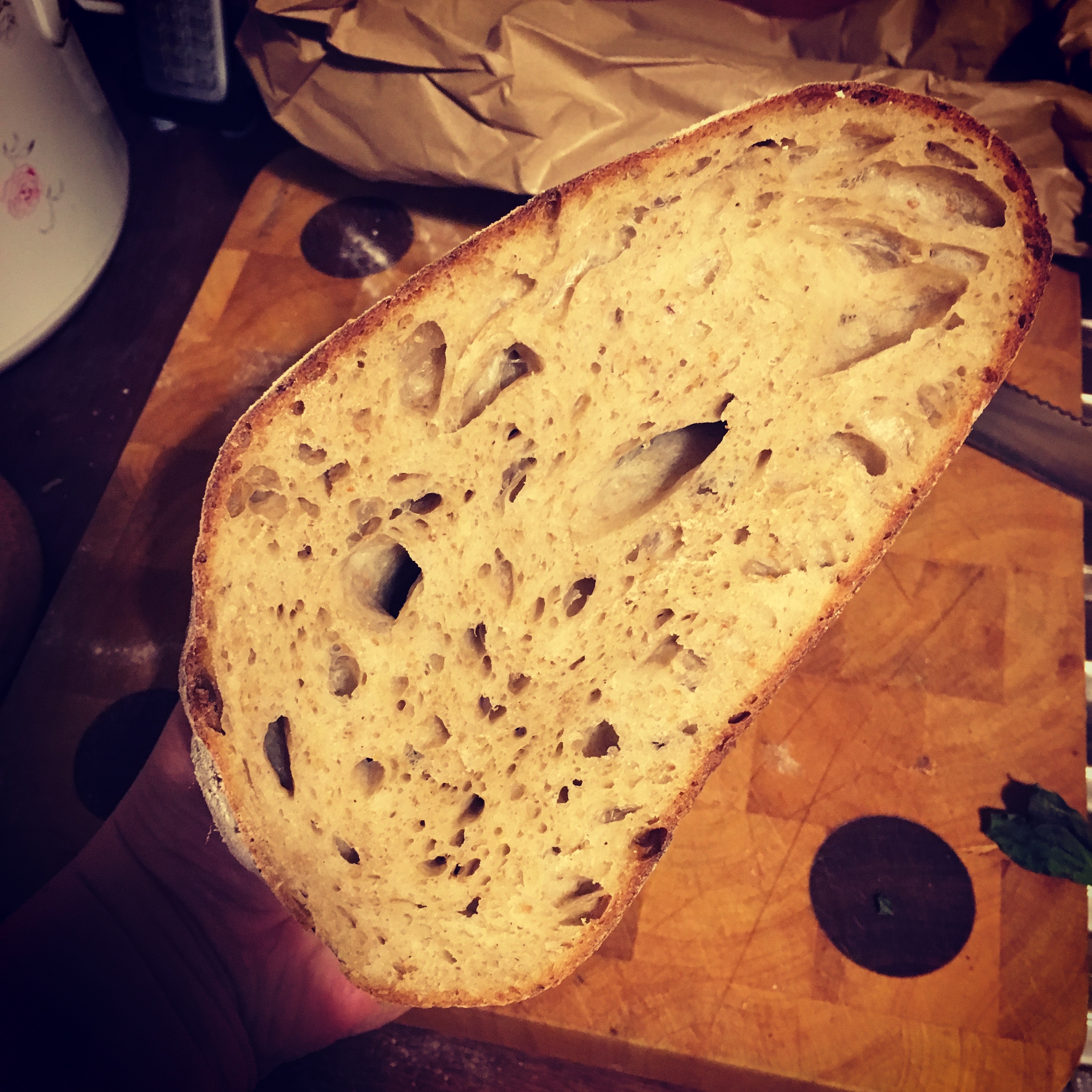Bakehouse Diary
Written by Piers Cawley on , updated
Back to the bakehouse
I know! It’s been a while. But we’re in! I have baked, and it was good. There’s still a ton of stuff to do (plumbing, mostly) but the really important bits of kit are all in place and looking good.
We celebrated getting in by turning one of the decks up as high as it would go and making lots of pizzas and a few loaves of bread.

Figure 1: An early pizza
The story so far…
In my last entry (over a year ago, argh! Gill is much better) the oven and all my kit were still in my garage, up on blocks waiting for Dad to build an A-frame so we could winch it up and assemble it. Which happened, and we managed to get one section of oven up onto the base. And there we stopped because the fully assembled oven is very tall, and the A-frame isn’t tall enough to accommodate a fully assembled oven + the winch + space for the straps (and my garage roof isn’t high enough to accommodate a sufficently tall A-frame). Still, it allowed us to start in on prEocess of breaking the heads of very old brass machine screws and generally failing to get the oven beds out where they could be cleaned. This was frustrating, but it’s not like I was unused to frustration.
Meanwhile, the bakehouse site moved again. We had thought it would be a relatively easy (and thus cheap) matter to run the necessary 3-phase power to the space, but it turns out there wasn’t quite enough power going to the building to support what we needed. That would mean a new substation and some very expensive cable laying. So it wasn’t going to fly. Luckily, there is also an old cafe in the yard. And it already has 3 phase, and enough 3 phase at that. So we set about making that into a bakehouse. A lick of paint; some new flooring; wider, taller doorways so we could get the oven in. Minor stuff like that.
By now we’re up to late spring of 2017. I’d given up on trying to renovate the decks myself, so I got onto Martin Passey at Becketts and arranged for them to sort out the electrics and replace the rusty steel beds with ceramic ones instead, which are generally reckoned to be the best choice if you want to make ‘hearth’ breads on the oven floor. We just needed to work out how to get the oven from Doncaster to Heywood.
Guess what? It wasn’t straightforward.
When we picked up my oven from the Isle of Wight, we’d got it into a large Luton bodied van with a tail lift, and it was kind of fine. I suppose I could have hired another one, roped in a few volunteers and driven it over myself, but the fact that we’d partially assembled the oven was going to make that rather trickier than it could have been. Disassembling it was going to be tricky too - after we got the straps out from the top decks when we’d assembled it, we discovered we’d been very lucky indeed, and the strap had very nearly broken.
The best option was to get a flatbed truck with a Hiab or similar hydraulic crane which would make short work of getting the oven up onto the truck and off to be fettled. But the access (up a 10 foot wide back lane) proved daunting. All the haulage companies I talked to took one look at it and backed away, muttering darkly and making the sign of the cross. “Get a bunch of strong Polish lads to carry it down the alley and stick it on the back of a truck” was the best (but very unofficial) suggestion. Not ideal.
So now it’s July and I’m chatting to a fellow guest at my brother’s silver wedding anniversary about my shipping woes. “You want to talk to Dan!” he said.
“Dan?”
“Yeah, Dan Punchard. He’s great, he’s moved a couple of lathes for me with some really tight access.”
“Thanks!”
My informant was not wrong. Dan was brilliant. We exchanged a few emails and photos of the access and bang the oven was off into the tender loving care of Becketts for its electrical fettling and new floors. And soon the money was flowing out of my savings as I bought a new spiral mixer, wire cooling baskets, steel work table, scales (both electronic for weighing ingredients into the mixer and a balance scale, which is still the fastest way of scaling dough when you divide it), lots of bannetons (probably not enough) from Bakery Bits, workwear, flour, wire shelving, and a bewildering amount of janitorial bits and bobs from Nisbets. Fettling the oven wasn’t exactly cheap, but wow, do those baskets add up!
It’s arrived, and it fits
On the 8th of December last year I sent mail Martin some mail with the subject “It’s arrived, and it fits!” and over the next couple of weeks the rest of the stuff I needed to bake arrived and, on the 20th of December, I fired up the mixer for batch of 16 loaves and what proved to be far too many pizza doughballs.
On Friday 21st of December, I pulled my first loaves out of my ~40 year old oven, and damn, but they were good.

Figure 2: The first loaf
What next?
Of course, no enterprise like this is ever finished, here’s a selection from my to do list.
Plumbing
A bigger sink! Water near the scale so I’m not carrying buckets back and forth! A handwash basin!
Qualifications
Environmental Health Officers do like you to have a certificate to show you’re not a complete moron when it comes to hygiene. Breadmaking is relatively low risk because everything gets so very hot during the cooking process, but even so.
Refrigeration
Right now everything’s at the ambient temperature, which can mean staying in the bake house until the early hours in order to get the loaves into the oven when they’re perfectly proved. A better approach would be to stick the dough into a retarder (big fridge, racked for standard bakers’ sheet pans) and bake them first thing in the morning after a decent night’s sleep. I have a retarder, but transport is annoyingly tricky because it’s 2m tall, and should ideally be transported vertically too.
Fitness
Right now, I can just about cope with two bakes a week, but if I’m going to actually make money at this, I’m going to need to be able to manage more. Hopefully, as I bake it’ll improve my fitness, so as demand grows I’ll be able to meet it.
Marketing
Oh boy, do I suck at marketing? Still, the product is good and there’s nobody else in the local area making this sort of bread, so I have a few advantages. I still haven’t made a Loafery website though. At least I have the loafery.co.uk domain.
Online ordering
If I can get people ordering online, I can use that to produce production schedules, and generally have a better idea of how much to make on each bake day, which help minimise any wasted bread. With two bakes done this year, I’ve sold every loaf - I’d like to keep that up.
In the next bakehouse diary…
I’ll talk about how a bake goes and the process of developing an initial range of products, sourcing flour and other ingredients and hopefully some news about online ordering.
